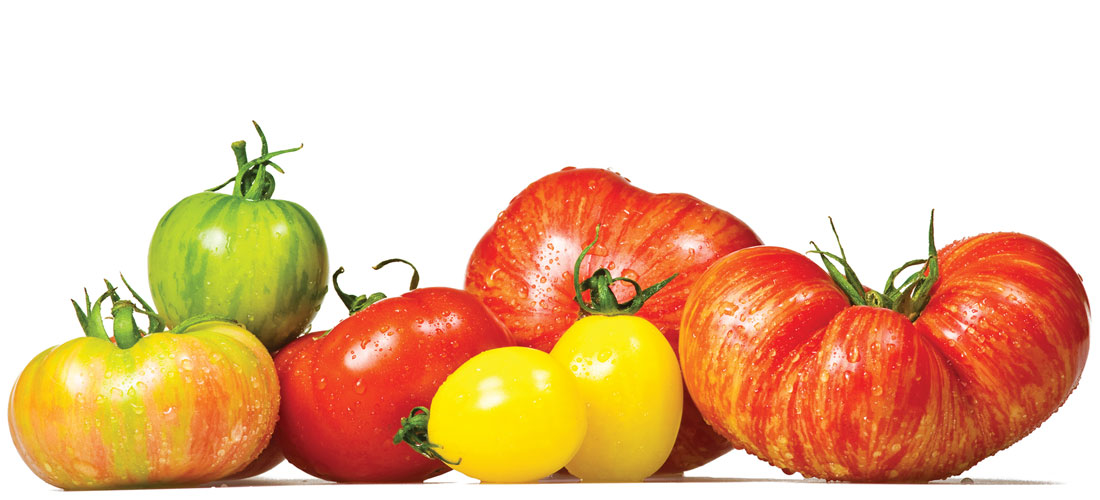
Hail the Tomato
The indispensible veggie/fruit/berry
By Michael Smith
Garden-fresh tomatoes will soon play center stage at Sandhills farmers markets. The things purporting to be tomatoes that we’ve endured all winter look like a picture. But then they also taste like a picture.
You say “tumahtoe,” I say “toomaydo,” the French and Spanish say “tomate,” Dutch say “tomaat,” and Italians say “pomodoro.” Whatever, those luscious little veggies soon will find their way onto our plates and delight our palates. Tomatoes are not just good, nay, they’re good for you. They’re chock-full of vitamins and stuff like lycopene, an antioxidant that is good for the heart and effective against certain cancers.
Americans love tomatoes. According to the USDA, the average American eats 23 pounds of tomatoes each year. And a Google search reveals that 93 percent of American gardeners grow tomatoes in their yards.
Did I say luscious “little veggies?” Should I have said luscious little fruits? Doesn’t matter to me and probably not to you. But back in the day, it did matter to the United States Supreme Court.
On May 10, 1893, the Supreme Court decided that tomatoes are vegetables. Case closed. That, despite the fact that, botanically, fruits — say, tomatoes, for example — surround their seed(s) with fleshy material. Vegetables don’t. (Bet you’re already wondering about seedless grapes, seedless watermelons, and seedless oranges.) The Supremes found that dictionaries did not sufficiently settle the question so, as it’s wont to do, the court decided the issue using the “common language of the people.” Most folks say tomatoes are vegetables.
Phytologists might have a word or two to contribute to that. They study plants and to them, tomatoes are more nearly a berry. New Jersey sides with the Supremes. There, the tomato is the state vegetable. In Ohio it’s the state fruit. Arkansas covers all bases. There the tomato is both the state fruit and state vegetable.
Moving right along, Americans grow tomatoes as annual plants, but they are actually perennials. They still grow wild in the Andes mountains. Actually, you can nurse the plants through the winter and plant them again next spring.
Tomatoes have an interesting history. One source traces them to the early Aztecs, circa 700 A.D. But by the time Spanish explorers began ripping off South America, tomatoes were pervasive and enjoyed by natives there as a food staple. They grew wild and they were also cultivated for food. In addition, they were regarded as an aphrodisiac, which probably had most to do with why tomatoes were sent back to Europe, along with everything else of value.
Once there, the French apparently took the aphrodisiac business to heart. They called the tomato pomme d’ amore or “apple of love.” Tomatoes were also embraced as part of the Spanish diet. Upper-class Brits took a pass on the things while lower-class Brits ate tomatoes with gusto. One theory about that is that the rich folks ate off pewter flatware with a high lead content. Tomato acid caused the lead to mix into the food and lead poisoning led to bad results. Poor people used wooden plates.
A more probable explanation for literate rich Brits eschewing tomatoes is that the tomato plant closely resembles the nightshade plant which is, in fact, poison and can even be fatal. Fast-forward to America’s Colonies. Tomatoes got off to a very slow start. Apparently, the nightshade/poison fiction came over with the Pilgrims. And the apple of love business was definitely not a hit with the Puritans. None of that “hot tomato” stuff.
High-profile dudes like Thomas Jefferson, Col. Robert Gibbon Johnson, and Joseph Campbell popularized tomatoes and ensured their place in our culture. Jefferson grew them in his garden and promoted their use in cooking. Johnson, as late as 1830, had the temerity to eat the things on the steps of a local courthouse, where folks lined up to watch him die. And in 1897, Campbell began marketing condensed tomato soup. Now, would Campbell Soup do you wrong?
Given the popularity of the tomato, a body might think America would be the largest tomato producer. Not so, it’s China. America’s second. In America, Florida grows the most fresh tomatoes, while California processes the most tomatoes used in soups, sauces, salsas, salads, ketchup and multitudes of similar commodities.
Tomatoes are not just garden-variety, either. In fact, there are a whopping 10,000 varieties of the vegetables, uh, fruits, uh, berries. And they come in red, pink, purple, black, yellow and even white. So there’s something for everybody.
Tomatoes are spacey. That’s right, according to NASA.gov, 600,000 tomato seeds traveled to the International Space Station and back. As part of the “Tomatosphere Project,” students in Canadian classrooms are using the seeds to grow plants and compare them with plants from seeds that didn’t get to go to space.
Here’s one for the books: The Guinness Book of World Records says between May 2005 and April 2006, a tomato “tree” grown in the Walt Disney World Resort greenhouse produced over 32,000 tomatoes in the first 16 months after it was planted. That scored the record for the most tomatoes in a single year. And here’s another: The heaviest tomato on record was produced in 2013 in Oklahoma. Weight — 7 pounds and 12 ounces. Put that in perspective by considering that the average tomato weighs a mere 4 ounces. Finally, Guinness says the world’s tallest tomato plant was 65 feet, grown in 2000 in Lancashire, United Kingdom.
All right, I promise this is the last one. There’s this little place called Buñol, which is a province of Valencia, Spain. Each year on the last Wednesday of August between 11 a.m. and 1 p.m., as many as 50,000 visitors from everywhere on Earth gather in Buñol for the “La Tomatina” food fight festival. On average, those nuts unleash 243,000 pounds of tomatoes at everything that moves and everything that doesn’t move. Hey, whatever rings your bell. PS
Michael Smith lives in Talamore, Southern Pines, with his wife, Judee. They moved here in 2017 and wish they had moved here years earlier.





